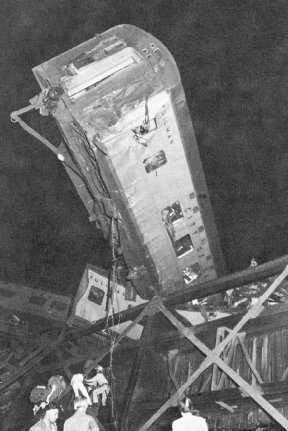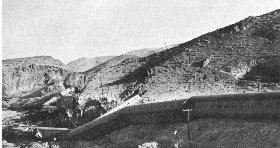HOWARD HICKSON'S
HISTORIES
[Index]
Recalling a Train Wreck
City of San Francisco Streamliner - August
12, 1939
On August 12, 1939, Southern Pacific's crack
streamliner, the City of San Francisco, derailed near Harney, Nevada, killing
24 people and injuring 121. Of those hurt, 32 required hospitalization.
A coroner's jury and a railroad hearing board
(is this the fox guarding the hen house?) both determined that the accident
was caused by sabotage - the deliberate moving of a rail to cause derailment.
This is a fairly straightforward solution.
Whoa, there! Although this disaster happened
more than six decades ago, doubt still exists in the minds of many area
old timers. Some believe it was a railroad cover-up while others accept
the sabotage scenario. Neither side strays from their opinion.
Luxury describes the streamliner promoted
as the fastest, most powerful ever designed and built. Its time from Chicago
to the west coast was less than forty hours. Almost a quarter of a mile
long, it was powered by six giant engines generating a monstrous 5,400
horsepower to pull the train's 1,207,151 pounds. The City of San Francisco
symbolized the ultimate in safety engineering. Following behind the power
units were cars emblazoned with San Francisco landmarks: Market Street,
Presidio, Mission Dolores, Nob Hill, Embarcadero, Twin Peaks, Fisherman's
Wharf, Chinatown, Gold Gate Park, Union Square, Seal Rocks, Telegraph Hill,
and Portsmouth Square. With comfort and speed it could carry up to 220
people - the crew and 171 passengers.
Although jointly owned by Southern Pacific,
Union Pacific, and Chicago Northwestern, I am using SP since the accident
happened on their tracks.
Engineer Ed Hecox, a 20-year SP veteran,
was at the controls. Pulling out of Carlin, Nevada he noted the train was
26 minutes behind schedule. He told the fireman they would arrive on time
at Oakland because he could throttle up to 90 miles an hour across Nevada.
F.S. Foote, Jr., a passenger, said the
train was hitting the curves uncomfortably after they left Carlin. He added
that two bottles of beer were thrown from their edged table onto the floor.
A woman was hurled from her seat into the aisle and everyone laughed. This
was a few minutes before the derailment. The train was, most certainly,
going faster than it had on previous legs of the journey.
It was 9:33 p.m. when Hecox said he
saw a tumbleweed on the tracks as the train approached Bridge Number Four.
He felt the unit lurch, then jump the tracks out of control. The train
traveled almost nine hundred feet before grinding to a halt. Five cars
dropped into the Humboldt River and three more went off the tracks and
down an embankment.
Hecox: "As the engine stopped, I ran
back. All I could hear was the screams and moans of the injured and dying.
Everywhere there was dust. I could not see a single living person." He
then ran down the tracks to Harney, about one and one-half miles away.
After making emergency telephone calls, he returned to the site with the
Beowawe section crew.
Joe Bell, an Elko barber, then 11 years
old, was one of the first on the scene. He came with his father and the
Beowawe constable. They heard pounding and found the section crew under
a car moving a rail. It was later claimed that the men were moving rails
back in place to get the last four cars back on the tracks to move survivors
out.
What survivors? Why wasn't the crew
rescuing passengers instead of repairing track? Many of those headed for
the hospital weren't taken to Elko until the morning on special trains
made up in Carlin.
 In the next few hours the accident scene
was filled with volunteers helping rescue efforts and those who came just
to look at the tragedy. This totally contaminated the area so that no real
clues could be found. A few people even picked up souvenirs to take home.
In the next few hours the accident scene
was filled with volunteers helping rescue efforts and those who came just
to look at the tragedy. This totally contaminated the area so that no real
clues could be found. A few people even picked up souvenirs to take home.
 During the investigation, divers recovered
tools from the Humboldt River and a couple of jackets were found in the
area. Railroad detectives maintained they were dropped by the saboteurs.
Shady characters, 26 of them, were arrested, questioned and released. Several
confessed but were written off as nut cases. Thousands were questioned
in the following months but no was ever charged.
During the investigation, divers recovered
tools from the Humboldt River and a couple of jackets were found in the
area. Railroad detectives maintained they were dropped by the saboteurs.
Shady characters, 26 of them, were arrested, questioned and released. Several
confessed but were written off as nut cases. Thousands were questioned
in the following months but no was ever charged.
The railroad conducted hearing only
added to the confusion by clearing the railroad of all wrongdoing. Some
claim they did this to head off future lawsuits. Intelligent, knowledgeable
people decided, after hearing the railroad's evidence, that there was no
doubt about the accident being caused by a moved rail.
Newspaper reporters were barred from
the hearing. They could do things like that then but the journalists still
bitterly complained.
An Elko newspaper photographer was accused
by the railroad of taking pictures from an angle which made the wreck look
worse than it was. He commented, "God knows, it would have been impossible
to make it look worse than it was."
Foote and other passengers claimed that
the streamliner was traveling very fast.
A sheriff and a constable both said
they could not find any evidence of rail tampering.
The FBI disagreed with the hearing decision.
Those who testified at the hearings
were mostly railroad employees and residents of railroad towns. Jobs could
have been lost if they charged the railroad with negligence.
If someone had been arrested, charged,
and convicted, perhaps the controversy would not still exist. There will
always suspicion and doubt about the cause.
Foote was eventually paid $7,500 which
almost covered his out of pocket hospital expenses. The SP refunded his
full extra fare price - five dollars, the amount he paid for traveling
on the City of San Francisco. The letter noted that the company technically
only had to refund the value of the unused portion but they were refunding
the full amount due to the interruption of their service. They did not
give back his regular ticket price.
Howard Hickson
July 10, 2002
Sources: "Recalling a Train Wreck" by Howard Hickson,
Northeastern Nevada Historical Society Quarterly (80-1) and "City of San
Francisco Wreck" by F.S. Foote, Jr., Northeastern Nevada Historical Society
Quarterly (90-1).
These publications are, of course, much more complete
than the extreme condensed version in this story. Quarterlies are available
in the Museum Store of the Northeastern Nevada Museum, Elko.
Photographs from the archives of the Museum.
©Copyright 2002 by Howard Hickson. Permission to
use is given but, if any portion or all of this article is quoted, proper
credit must be given.
[Back to Hickson's
Histories Index]
|

